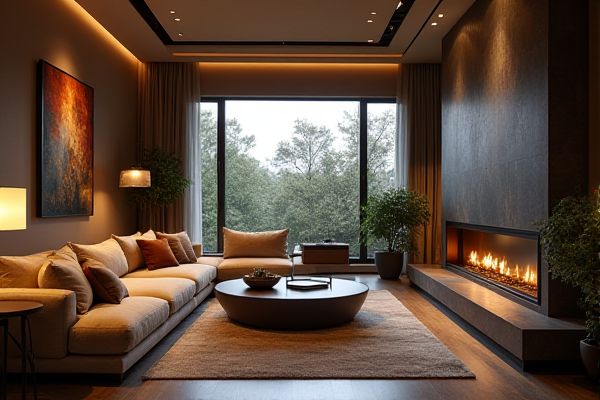
Layered lighting combines ambient, task, and accent lights to create a balanced and versatile atmosphere, while task lighting focuses specifically on illuminating areas where detailed activities occur, enhancing functionality. Explore the rest of the article to discover how choosing the right lighting strategy can transform Your space and improve everyday living.
Table of Comparison
| Feature | Layered Lighting | Task Lighting |
|---|---|---|
| Definition | Combines ambient, task, and accent lighting for a balanced environment. | Focused light designed to illuminate specific tasks or activities. |
| Purpose | Create depth, mood, and functionality in a space. | Provide sufficient illumination for reading, cooking, or working. |
| Light Sources | Mix of ceiling lights, wall sconces, and accent lamps. | Desk lamps, under-cabinet lights, and pendant lights. |
| Flexibility | High - allows control over light intensity and zones. | Low - fixed to specific areas. |
| Benefits | Enhances ambiance; reduces eye strain; improves aesthetics. | Increases visibility; promotes productivity and safety. |
| Common Use Areas | Living rooms, dining rooms, and bedrooms. | Kitchens, offices, and workshops. |
Introduction to Layered Lighting and Task Lighting
Layered lighting combines ambient, task, and accent lights to create a balanced and flexible illumination scheme that enhances the functionality and mood of any space. Task lighting specifically targets areas where activities such as reading, cooking, or working occur, providing focused brightness to improve visibility and reduce eye strain. Understanding the difference between layered lighting and task lighting helps you design more effective, comfortable environments tailored to your specific needs.
Defining Layered Lighting
Layered lighting combines ambient, task, and accent lighting to create a balanced and versatile illumination scheme that enhances both functionality and aesthetics. It integrates multiple light sources at different levels and intensities to adapt to various activities and moods within a space. Defining layered lighting involves understanding how these elements work together to provide comprehensive coverage and depth beyond the single-focus approach of task lighting.
What Is Task Lighting?
Task lighting is a focused illumination designed to enhance visibility for specific activities such as reading, cooking, or working at a desk. It provides concentrated light directly on work areas to reduce eye strain and increase productivity. Compared to layered lighting, which combines ambient, accent, and task lighting for overall balance, task lighting serves a precise functional purpose by delivering targeted brightness exactly where needed.
Key Differences Between Layered and Task Lighting
Layered lighting combines ambient, task, and accent lighting to create a balanced and flexible illumination scheme, enhancing both functionality and atmosphere in a space. Task lighting specifically focuses on providing concentrated light for activities requiring precision, such as reading or cooking, ensuring clarity and reducing eye strain. The key difference lies in layered lighting's holistic approach to lighting design versus task lighting's targeted use for practical purposes.
Benefits of Layered Lighting
Layered lighting combines ambient, task, and accent lighting to create a balanced, versatile illumination scheme that enhances both functionality and aesthetics in any space. This approach reduces eye strain by providing appropriate light levels for different activities while improving the room's depth and dimension through varied light sources. Integrating layered lighting also offers greater energy efficiency and control, allowing users to customize brightness and mood according to specific needs.
Advantages of Task Lighting
Task lighting provides focused illumination that enhances visibility for specific activities like reading, cooking, or working, reducing eye strain and improving productivity. It allows you to customize lighting levels exactly where needed, promoting comfort and precision in daily tasks. This targeted approach conserves energy by illuminating only the necessary areas, making it an efficient and practical lighting solution.
When to Use Layered Lighting
Layered lighting combines ambient, task, and accent lights to create a balanced and flexible environment suited for various activities and moods. Use layered lighting when you need to enhance the functionality and aesthetic appeal of a space, ensuring that You can adapt the lighting for detailed tasks, relaxation, or social gatherings. This approach is particularly effective in living rooms, kitchens, and offices where versatile lighting enhances both productivity and comfort.
Ideal Applications for Task Lighting
Task lighting is ideal for specific activities that require focused illumination, such as reading, cooking, sewing, or office work, where precision and clarity are essential. It reduces eye strain and enhances productivity by providing direct light on work surfaces or areas that demand detailed attention. Common fixtures for task lighting include desk lamps, under-cabinet lights, and pendant lights positioned to minimize shadows and glare.
Combining Layered and Task Lighting for Optimal Results
Combining layered lighting with task lighting enhances both ambiance and functionality in any space by integrating ambient, accent, and task-specific light sources. Layered lighting creates depth and dimension through multiple fixtures, while task lighting ensures focused illumination for activities like reading or cooking, reducing eye strain and improving efficiency. Strategic placement and adjustable features in task lighting complement layered setups, resulting in a balanced, adaptable lighting design tailored to diverse needs.
Choosing the Right Lighting Strategy for Your Space
Layered lighting combines ambient, task, and accent lighting to create a versatile and balanced illumination scheme tailored to various activities and moods within a space. Task lighting prioritizes focused, high-intensity light sources designed for specific activities such as reading, cooking, or working, enhancing functionality and reducing eye strain. Selecting the right lighting strategy involves assessing room purpose, natural light availability, and user needs to achieve optimal comfort, efficiency, and aesthetic appeal.
 homyna.com
homyna.com